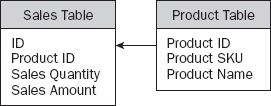1.2. Key Elements of a Data Warehouse
Learning the elements of a data warehouse or data mart is, in part, about building a new vocabulary; the vocabulary associated with data warehousing can be less than intuitive, but once you get it, it all makes sense. The challenge, of course, is to understand it in the first place. Two kinds of tables form a data warehouse: fact tables and dimension tables.
Figure 1-3 shows a fact and a dimension table and the relationship between them. A fact table typically contains the business fact data such as sales amount, sales quantity, the number of customers, and the foreign keys to dimension tables. A foreign key is a field in a relational table that matches the primary key column of another table. Foreign keys provide a level of indirection between tables that enable you to cross-reference them. One important use of foreign keys is to maintain referential integrity (data integrity) within your database. Dimension tables contain detailed information relevant to specific attributes of the fact data, such as details of the product, customer attributes, store information, and so on. In Figure 1-3, the dimension table Product contains the information Product SKU and Product Name. The following sections go into more detail about fact and dimension tables.
Figure 1.3. Figure 1-3

1.2.1. Fact Tables
With the end goal of extracting crucial business insights ...
Get Professional Microsoft® SQL Server® Analysis Services 2008 with MDX now with the O’Reilly learning platform.
O’Reilly members experience books, live events, courses curated by job role, and more from O’Reilly and nearly 200 top publishers.

